Introduction
“All came up from the beginning. The egg from which they
first developed into tadpole form was deposited, with millions of others,
in one of the warm pools.... Down the warm stream from the pool floated
the countless billions of eggs and tadpoles, developing as they drifted
slowly toward the sea. Some became tadpoles in the pool, some in the sluggish
stream and some not until they reached the great inland sea. In the next
stage they became fishes or reptiles, An-Tak was not positive which, and
in this form, always developing, they swam far to the south, where, amid
the rank and teeming jungles, some of them evolved into amphibians. Always
there were those whose development stopped at the first stage, others whose
development ceased when they became reptiles. Few indeed
were those that eventually developed into baboons and then apes, which
was considered by Caspakians the real beginning of evolution.
From the ape the individual, if it survived, slowly developed into the
lowest order of man -- the Alu -- and then by degrees to Bo-lu, Sto-lu,
Band-lu, Kro-lu and finally Galu. And in each stage countless millions
of other eggs were deposited in the warm pools of the various races and
floated down to the great sea to go through a similar process of evolution
outside the womb as develops our own young within;
Here we have the unique evolution of Caspak in a nutshell,
a super-lamarkian ‘by your own bootstraps’ opposed to gradual evolution.
From pollywog, through amphibian, reptile, monkey, caveman to true human,
all in one generation. On Caspak, hominids, which for convenience
we will call Lu, progress from Ho-Lu (apes) through Alu, Bo-lu, Sto-lu,
Band-lu, Kro-lu to Galu (modern man).
Other writers have ably traced the genesis and make up
of the intellectual ideas that give rise to Burroughs pseudo-scientific
romance. I don’t propose to do that here. Instead, in
this essay, I will assume that Caprona and its species are more or less
as Burroughs describes it. Where there is ambiguity, such as whether
dinosaurs also follow this super-lamarkian path, I'll make a conservative
judgment. But where something is clearly stated, then obviously,
it must be accepted.
The Anomalous Sources
of Animal Life in Caspak
Biologically Caspak is a mess every which way.
Before we tackle the strange life cycle of the Lu people, let's take a
look at the Fauna and try and make some judgments.
First, all or almost all of the known species in Caspak
appear to have analogues in the outside world at some point in history.
If we accept Burroughs literally, the fauna of Caspak are exactly those
as found in the fossil record.
This seems to make sense. The alternate explanation
is that Caspak is somehow independently evolving creatures identical to
assorted prehistoric and existing species. This seems quite patently
to go against every biological concept that we know of.
Instead, I think we have to assume that if something resembles
an Allosaur or a Horse, then it actually is an Allosaur or a Horse and
shares a common ancestor and common descent with those specimens found
alive or in fossil pits elsewhere. No independent genesis.
Normally, this would go without saying, but Caspak is such an odd place
that it is worth articulating.
But there is a very odd mixture of animals.
The time factor is obvious of course, we're mixing various Mezosoic Era's
giant reptiles with Pleistoscene Era's giant mammals. But it goes
deeper than that.
Of the identified reptiles we see: Plesiosaurs,
Pterodactyls, Allosaurs, Tyrannosaurus Rex, Snakes, Huge Lizards, Diplodocus.
Here is a puzzle. Lizards and Snakes, of course, are common to every
era. Plesiosaurs ranged throughout the Mezosoic. But the next
members posed problems. Allosaurs and Diplodocus were creatures of
the Jurassic era only. Tyrannosaurs and Pterodactyls were Cretaceous
creatures only. They never coexisted temporally. Nor
did either set coexist with large mammals.
Of the identified mammals, we see: Mammoths,
Mastodons, Bison, Rhinoceros, Sabretooths, Tibers, Hyeanodons, Hyeanas,
Aurochs, Deer, Monkeys. Cave Bear, Cave Lion, Lions, Panthers, Leopards,
Lynx, Tigers, Cows, Red, Eohippus, Horses Red Deers, Goats, Megatherium,
Wooly Rhino, Wolves. There are some anomalies here. The
Megatherium was common only to South and North America, not the old world.
The Bison were a North American species. Meanwhile Aurochs were creatures
restricted to Europe and Asia, the Cave Bear was a European only creature.
Tigers were restricted to Asia, and Leopards to Africa. Several
of these animals are current, having come into existence in their present
form only a few million years ago at most, and still exist, or died out
as recently as a few tens of thousands of years ago. Oddly, given
Caprona's location, there are no representatives of known Australian existing
or extinct species. Apart from the Megatherium, there are no
representatives of current or extinct South American species.
In short, not only is the temporal distribution anomalous,
but the geographical origins of these creatures are anomalous as well.
They come from at least three or four distinct locations and at least as
many different eras. This begs the question: How did
they get there?
The Physical Origins of
Species
One could imagine Dinosaurs or Prehistoric mammals wandering
into an adjacent region which then is then separated from the rest of the
lands by the sinking of a land bridge or surrounding areas, or by the development
of swamps, geological uplifts, barrier mountains, and thus surviving as
living fossils for millions of years.
But this doesn't seem to be the case here. Caspak
is isolated in the South Pacific, its closest neighbors are Antarctica,
South America, New Zealand and Australia. It shows no sign
of any of those continents fauna, with the possible exceptions of the Megatherium.
It's remotely possible that some of the animals are actually Marsupial
or Liptotern copies from parallel evolution in Australia or South America.
The Marsupials produced their own versions of lions and sabre toothed tigers.
But there's no indication of that.
So, how do we explain Cave Bears, Tigers and Megatherium?
Presumably, Caspak either had contact with their original continents, or
with some other location to which these animals had migrated.
If Caspak did make contact with continents repeatedly to pick up new species,
why aren't Caspak's preserved fossil species re-introduced into the continents?
Why didn't the dinosaurs make a comeback? There doesn't seem to be
any coherent mechanism that would allow new species into Caspak without
old ones getting out?
Another mystery is how Caspak has preserved the extreme
profusion of fauna, and in particular, the great size of the Megafauna.
On much larger islands like Madgascar or Sicily, the tendency has been
for giant species like the Hippo or Elephant to shrink into dwarf varieties,
even as small species grow larger. Yet if anything the Megafauna
are as diverse as ever and even larger than originally found.
Is Caspak some sort of floating island, motoring around,
connecting up first with North America, bouncing off Europe, toodling through
the Indian Ocean sliding against Asia, and finally into the South Pacific?
And bumping repeatedly against continents for a hundred million years?
What kind of journey makes sense? What are the mechanics?
Plate tectonics acknowledges that continents and land
masses do move, so it is remotely possible that a comparatively small subcontinental
plate might travel, and perhaps travel more rapidly than large continental
plates. The barrier cliffs should erode over millions of years,
but it is possible that the wandering journey built them back up again.
It's possible that the geography has occasionally allowed new species in,
without allowing old species to get out, something like a lobster pot.
It is also remotely possible that Caspak's bowl shaped structure preserved
a fairly stable climate, no matter what latitude it was in, which would
prevent species extinction. But all of this seems extremely
improbable. I'd have to assign the ‘Wandering Caspak’ notion
a low order of probability.
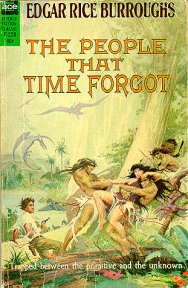
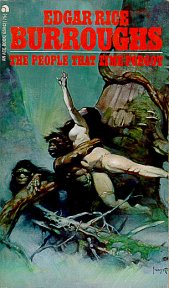

A Pellucidar Connection?
The more likely explanation is that Caspak's fauna are
all derived from a single source, rather than a hundred million year wandering
journey. Unfortunately, there is no potential candidate on
Earth. Even other ‘lost worlds, such as Pal Ul Don, Skull Island
or Maple White Land do not show the temporal and geographic diversity of
Caspak.
There is one place where presumably all of Caspak's fauna
coexists together: Pellucidar. This may be cheating in
the sense of offering up one impossibility as an explanation for another
impossibility. But nevertheless, Pellucidar is well established
in Burroughs canon. There are several chronicles of Pellucidar, and
direct or indirect crossovers (through the Gridley wave communications)
with Tarzan, Mars, Venus and the Moon. Both Pellucidar's existence
in Burroughs world, and peculiar mixture of every conceivable flora and
fauna of Earth's history must be conceded. In particular, Pellucidar
is the home for almost every species found on Caspak.
So, how does Pellucidar's life get to Caspak?
Or a better question: How does all of Earth's history of life
wind up in Pellucidar? As to the latter question, it is dealt
with in another paper. On the former question, there are two possibilities.
The first possibility is Antarctica. Antarctica
is at one of the polar openings, but the indications are that it was not
always glaciated. It is possible that Antarctica was once a
fertile, live continent, colonized by or an out post of Pellucidarean life.
In which case, Pellucidar might have colonized Antarctica, which then in
turn, colonized nearby Caspak.
There is an alternative: I have offered up detailed
discussions of Pellucidar elsewhere, which discuss geography, geology and
dynamics of this strange realm, including the possibility that gateways
or openings periodically open between the inner and outer worlds outside
of the polar openings. Caspak may be or may be in one of these gateways.
In fact, there is some evidence to suggest that Caspak
is or was on the gateway, or the threshold of one of the gateways:
It's obscurity. It is simply too large a piece of land not
to have been previously explored if situated normally. In fact,
other large South hemisphere islands, even relatively smaller ones, were
thoroughly mapped and charted, and occasionally settled. As
examples, we have the British possessions of the South Georgia and Falklands
Islands in the Atlantic, as well as the French possessions of the Crozet
and Kerguelen archipelagos in the Indian Ocean. Hence, we need
a coherent explanation for Caspak's relative isolation and obscurity.
Thus, our theory, as outlined in the Pellucidar essay, that Caprona is
actually concealed below the line of Earth's curvature within an ocean
‘gateway’ to Pellucidar, in an area for which conventional navigation is
problematic.
Peculiarities of Apparent
Hominid Development
So, what about the strange life cycle of the inhabitants?
The ‘ontogeny recapitulating phylogeny’ of evolution which takes place
for the Lu people on Caspak.
Some observations need to be made. First,
Caspak's peculiar evolution is not universal. The Wieroo are an explicit
notable exception to this odd rule, they reproduce themselves in the usual
way... Or at least, sort of usual.
It also seems likely that the variety of animals are reproducing
in the usual way. It's possible of course that some of the eggs released
by females develop into pterodactyls, allosaurs and mammoths, but there
seems little evidence or support for this. Certainly the progression
of evolution comes to a crashing halt... Pterodactyls do not evolve
into Allosaurs which do not evolve into Mammoths. It's possible
that you might get an Allosaur evolving up to a Tyrannosaurus, or a Mastodon
evolving up to a Mammoth.
But that seems dubious. We note that the ‘primates’
of Caspak work their way up an ancestral pecking order. Thus,
the highest of Caspak humans might count all the pre-human forms in his
ancestry.... But certainly, no human ever counted a Mammoth or Allosaur
in his lineage. No, the most workable assumption is that Caspak's
peculiar evolution is confined to the apparent hominids.
There is a peculiar anomaly with respect to hominids reproduction,
it appears that all of the different levels of hominid are laying eggs
in the warm pools. This raises the odd possibility that hominids
may lay eggs which eventually evolve into a higher form of being than they
themselves. If this is the case, then it suggests that the ‘evolutionary’
progression is locked into the genetic code of these hominids.
If they are hominids.....
But then, what else can they be? The higher
levels of the Lu are indistinguishable from human. These are
creatures with human proportions, skin tones, facial features, secondary
sex characteristics, with language and technology and animal husbandry.
Except for their peculiar reproduction, they are human in every conceivable
respect.
And yet, their peculiar reproduction sets them apart,
and suggests that they are actually something else. But what?
An Amphibian Origin?
Frogs dammit! They're frogs!!!
Let's take a careful look at that notion.
Frogs, even modern common frogs, already have human-ike proportions.
They have long legs in proportion to their arms, similar proportions as
in humans. Their front paws have splayed fingers, almost like
hands, and their back paws feature long digits. In the Amazon,
frogs are arboreal tree climbers, hence they exist in the same realms as
primates.
So, it might be possible that frogs, with millions upon
millions of years to work with, managed to evolve giant tree climbing or
jungle forms the size of humans or larger. It's also remotely
possible that with uninterrupted evolution and no competition, frogs might
evolve bipedal upright walkers, which would result in a roughly human-like
creature. Ultimately, its just loosely possible that frogs
might evolve a human-like intelligence.
I'll admit, it's a long shot. There's a lot
of evolving that frogs would have to do. They're making do,
for instance, with comparatively primitive two chambered hearts.
They are cold blooded creatures, which limits the metabolic energy available
to them. Their lungs are not terribly efficient, amphibians employ
a ‘throat pump’ to push air in and out of lungs, while reptiles innovated
the bellows lungs we have today. So a human sized frog would
be quite handicapped. There have been in pre-history, amphibians
that reached human sizes or far greater, but by and large, we have to assume
that these creatures were relatively slow. Sudden spurts of energy
would be compensated by long periods of rest and inactivity.
We should not consider the primitive features of modern
amphibians to be definitive of amphibians biological limitations.
For one thing, these ‘primitive features’ have served them well in their
present forms and niches, they've managed to outlast both Dinosaurs and
Giant Mammals and may well outlast us.
And in fact, during the Permian period, before the ascension
of the Dinosaurs, several known species of Amphibian reached lengths of
three to six feet, with a few giants of ten to fifteen feet. They
coexisted with and competed effectively with their reptile cousins.
The only true limitation was their method of egg laying. Move
to hard shelled eggs, and they are automatically reptiles.
The Permian Amphibians suggest that they were quite capable of sophisticated
adaptations.
Among the remarkable permian forms was a sailback Amphibian,
Platyhystrix, which coexisted with the reptilian sailbacks like Dimetrodon
and Edaphosaurus. There was also an armored form, Peltobrachus,
which resembled an armadillo. Paracyclotosaurus was an eight
foot creature resembling a crocodile. Another near crocodilian,
Eogyrinus, reached lengths of fifteen feet.
Diadectes, at only ten
feet but with a massive frame, was one of the heaviest animals alive during
its period, it was the first known amphibian herbivore and contemporary
with reptile herbivores.
In short, during their heyday in the Permian period,
they did quite interesting things.
Of course, the Permian Reptiles gradually but steadily
forced them out of their niches, so however advanced the Amphibians became,
the Reptiles were matching or more than matching. In the late
Permian period, for instance, many of the Amphibian forms were becoming
armoured, obviously as adaptations against Reptilian predators.
It's interesting to speculate as to how Amphibians might
have continued to evolve, if not pushed out by Reptiles. Perhaps
on some ancient equivalent of Madagascar or Australia, an Amphibian population
free of reptiles was able to evolve remarkable forms. Or would such
creatures evolve without competition from Reptiles? Would they
simply lay there? Or would they produce forms that would or could
have endured the inevitable onslaught? It is notable that the
earliest frogs originate from Madagascar.
How Could Frogs Seem Human,
and Why Would They Bother?
The big obstacle to the frog theory is the limits of
parallel evolution. It's quite possible that in some sufficiently
isolated tropical biological laboratory, frogs produced a parallel to hominids,
possibly even semi-intelligent or intelligent parallels. Possible,
though not necessarily probable.
But there's normally a limit to parallel evolution.
Sharks and Dolphins share a body shape from parallel evolution.
No one will ever mistake them. Parallel evolution is very good
at general forms. It's terrible with the fine details, sometimes
spectacularly so... A kangaroo is parallel evolution's idea of a
deer. So our frog man is not likely ever to be mistaken for
a human.
Except that there is one evolutionary or adaptive feature
which might come into play. Batesian Mimicry. This
is the phenomena where, in order to escape or dissuade predators, one animal
evolves to resemble another animal or object. There are numerous
examples of this in the insect world... Insects that have evolved
to resemble leaves or sticks, or flies which have evolved to resemble wasps.
The phenomenon is not well known among vertebrates, but there are fish
that seem to engage in it, and vertebrates are well known for camouflage.
So, if we have a ‘frog man’, it is possible that our ‘frog
men’ have been evolving to resemble humans, even to the point where they
could pass for humans. Why or how?
Because hominids, beginning with Australopithecus or Homo
Erectus may have practiced their own natural selection - creatures that
looked humanoid, but not human enough, might be killed. Those
that looked human enough might be spared or even protected.
A greater resemblance to humanity might facilitate surviving encounters.
A great enough resemblance might enable one to obtain support and protection,
it might offer a ‘frog man’ safety within a human village or tribe.
Primates of all sorts have complex social behaviour.
Even non-human primates, apes or monkeys, will tend to be territorial,
particularly against rival apes or monkeys of their own species, but also
against competing apes or monkeys of other species. On the
other hand, they are tolerant and supportive of members of their own band
or troop, even while aggressive towards other bands and troops.
Moreover, they will admit new outside members to their troop, or tolerate
outsiders in certain situations.
Wandering males may be evicted from one monkey troop,
and eventually find acceptance in another. Among Baboons, subordinate
males or females can be adopted. Meanwhile, in the case of a solitary
ape like the Orangutang, adult males will drive all other adult males from
their territory, while being hospitable to subordinate or juvenile males,
and particularly subordinate to females. Among known stone
age human groups, foreign females were often incorporated into social groups,
and in fact, were actively stolen.
So, a sufficiently humanoid bufoid, sufficiently resembling
either a subordinate or juvenile male, or a female might well manage to
insert itself into a primate band, obtaining the safety of the troop and
the protection of the more powerful members. It would never
be an apex creature, dominant males and females tend to oppose rivals trying
to join, and anyway, the life of a dominant is feet first.
True hominids would probably be far more efficient and
effective than bufoid humanoids. In direct competition, the
frog men would lose out, so rather than being beaten, they were joining.
As well, hominids were swiftly becoming apex predators and dominating regions
in which they existed. So imitating humans might well cut down on
pressure from other predators, and improve the eating by sharing in human
kills. Under the right circumstances, the adaptive pressure
to copy humans might have been quite strong and quite effective.
And likely, it occurred over a vast period of time.
The hominids of Caspak appear to adopt a series of guises, from australopithecine
to homo erectus to neandertaloid to true human. This may imply
that the mimicry has been going on for millions of years. It
is likely that in nature alongside hominid communities, the amphibian dopplegangers
would zero in on whatever evolutionary stage the hominids were, passing
through previous forms quickly and imperceptibly.
In isolation, without a hominid population to imitate,
they may well pass through each stage more deliberately. Lacking
biological or social cues, the amphibian humanoid probably spends time
in each accumulated stage before moving on.
So what about the various handicaps? It might
be possible for the amphibians to move to bellows lungs, or improve a throat
pump to the point where its appearance and function are similar.
It seems unlikely that they would make the leap from cold blooded to warm
blooded, but then again, Caprona is permanently wet, humid and warm due
to its inverted bowl shape and volcanic heating, so in fact, being cold
blooded may not be as much of a handicap here. The Caprona environment
may well be perfect for amphibian para-hominids.
Textual Evidence to Support
the Amphibian Theory
Is there any evidence to support this elaborate contention?
Well, apart from the fact that the females lay vast quantities of eggs
in the water, which then hatch as fish, morph into tadpoles and eventually
lose their tails to become land dwellers? Some...
For one thing, Burroughs himself seems uncomfortable characterizing
his creatures as fully human. Burroughs himself repeatedly refers
to the egg spawn as tadpoles and makes direct reference to the life cycle
of frogs.
“From the egg, then, the individual developed slowly into
a higher form, just as the frog's egg develops through various stages from
a fish with gills to a frog with lungs. “ (Out
of Time's Abyss, Chapter 3)
When describing Ajor, a native Galu female encountered
by Thomas Billings, one of the outsiders, Billings refers to her as in
peculiar terms:
“She was quite the most wonderful animal that I have ever
looked upon, and what few of her charms her apparel hid, it quite effectively
succeeded in accentuating.” (The
People that Time Forgot, Chapter Two)
Behavioural Evidence of
Non-Human Nature
But another clue might be in the ‘instinctual’ nature
of the Capronans intelligence. When they move from one stage
to the next, they do not need to be taught skills. Instead,
they simply know by instinct. Hardwired or instinctive abilities
to use tools at certain stages of development may be more symptomatic of
a doppleganger creature, than a true human. For this, let us
consider the words of Tomar, a recently ascended warrior:
"Last night, in the very middle of the night, the call
came to me. Like that it came into my head" -- and he struck his
hands together smartly once -- "that I had risen. I have been waiting for
it and expecting it for a long time; today I am a Kro-lu. Today I go into
the coslupak" (unpeopled country, or literally, no man's land) "between
the Band-lu and the Kro-lu, and there I fashion my bow and my arrows and
my shield; there I hunt the red deer for the leathern jerkin which is the
badge of my new estate.” (The
People That Time Forgot, Chapter 4)
This is a peculiar thing. For this man, he does
not possess the skills or knowledge to make and use bow and arrows as a
Band-lu. Yet, he will not learn these skills from other Kro-lu.
Rather, in order to join the Kro-lu, he has to demonstrate these skills
at the outset. It appears that the tool making or tool using
skills are innate with the transformation, not requiring learning at all.
Essentially, this is tool making instincts refined to a high degree.
Social behaviours also seem to be hardwired into them:
"But why do you wish to kill me?" I asked.
He (Tomar) looked puzzled and finally gave it up. "I do not know," he admitted.
"It is the way in Caspak. If we do not kill, we shall be killed, therefore
it is wise to kill first whomever does not belong to one's own people.
This morning I hid in my cave till the others were gone upon the hunt,
for I knew that they would know at once that I had become a Kro-lu and
would kill me. They will kill me if they find me in the coslupak;
.....It was difficult to bring myself to take a human life. I could feel
no enmity toward this savage barbarian who acted almost as wholly upon
instinct as might a wild beast, (The
People That Time Forgot, Chapter 4)
This automatic or instinctive motivation to kill rivals
or outliers confuses the new Kro-lu. He doesn’t understand why he
needs to do this, he simply accepts the instinct.
And in fact, instinct may be the only way Caspak can work.
Assuming that each Caspakian comes up individually, then there is almost
no room for human social development. Human society is built
around families, around the need to protect and nurture children.
The generational bonds hold primate societies together, thus the dominant
units in monkey societies are mother/daughter bonds, which can extend even
unto grandmothers. Sons are affiliated with mothers among monkeys,
while fathers are the most peripheral members of society. Among baboons,
troops are organized around powerful dominant males, their females, and
then subsidiary males and juveniles. Among humans, complex
lines of kinship, parentage and family ties are the social glue holding
communities together.
By and large, at the core of any primate society are individuals
who are closely related, who are born one from another, or who grew up
closely together at the same time. In Caspak, however, no individual
can be sure of being closely related to any other individual. Nor
will any individual necessarily grow and mature with or on the same schedule
as any other individual, they are all on separate journeys.
There is not even the minimum need for a commitment of
male and female to raise young. Even birds find this commitment necessary
to build their nests, care for their eggs and eventually feed their hatchlings.
Among Caspakians, all a female does is drop some eggs in the pool in the
morning and then gets on with her day. There seems little motivation
to bond a male and female strongly or for any length of time.
"It will do them no good," remarked the man, a trace of
excitement in his voice. "It will do them no good, for the lion will wait
until they come out and take as many as he can carry away; and there is
one there," he added, a trace of sadness in his tone, "whom I hoped would
soon follow me to the Kro-lu. Together have we come up from the beginning."
This may seem evidence of enduring commitment. But
look again, To-Mar is quite prepared to follow his instinctive programming
and leave So-Al behind. Further, he shows only mild and a rather
intellectualized regret at her imminent passing. This is a
woman who has been his companion ‘from the beginning’ literally, through
several incarnations, but he can only manifest a ‘trace’ of sadness.
On the other side of the coin, there is a decided lack
of motivation for adults to teach skills. Parents teach their
children, adults teach adopted juveniles. Among Caspakians,
there are no children, there are only ‘newly ascended’, who have no discernible
filial relationship with their older peers. Among primate societies,
culture, including language and tool use, is transmitted between linked
generations. Among Caspakians, there are no linked generations, simply
a lot of unrelated individuals passing through. Ultimately,
Caspakians of a group are effectively strangers to each other, fellow travellers
without sentimental ties, but not true friends or companions.
“Twice were members of his band mauled, and one was killed
by a huge and bellicose rhinoceros; but the instant the action was over,
it was as though it never had occurred. The dead man was stripped of his
belongings and left where he had died;” (The
People that Time Forgot, Chapter 5)
Based on this then, it seems remarkable that the Caspakians
group socially at all. Yet, not only is each level of Caspakian
an increasingly sophisticated tool user, but their linguistic and social
capabilities grow as well, and not just grow, Caspakians seem driven to
associate in bands, tribes and villages of their own kind just as automatically
as they show hostility to outsiders. And this despite the lack of
inbuilt social dynamics of child rearing or intergenerational ties that
holds most human and animal societies together.
So, given this set up, it appears that the Caspakians
basic behaviours are strongly driven by instinct. They can reason,
they betray human emotions, they are self motivated. But core motivations
and skills appear to be hardwired.
Is this human behaviour? Are hominids feasibly
hard wired to this extent, or capable of being hard wired?
I don't believe so. Outside of Caspak, instinctual drives to this
degree seem absent from humans. On the other hand, lower animals,
like amphibians, may have a very high degree of complex instinctive behaviour
wired into them.
The Caspakians instinctual wiring suggests that they are
imitating human behaviours. Indeed, the wiring seems expressly
designed to imitate and *infiltrate* human societies. Thus,
Tomar says:
“so will the Kro-lu (kill me) if they come upon me before
I have won my Kro-lu weapons and jerkin.” (People
That Time Forgot, Chapter 4)
In other words, Tomar needs his weapons and jerkin in
order to win acceptance in Kro-lu society. He must be able to pass
first, as a member of society, before he can join society.
That’s an intriguing distinction. Most individuals become members
of society by slowly learning its rules. Only an infiltrator
learns the rules before he attempts to join.
In short, To-Mar evolves into a higher form, and then
goes about obtaining the tools and accoutrements that will allow him to
insert himself into a group of other individuals of this higher form.
Essentially, instinctive mimicry.
Returning to Pellucidar
Of course, if this theory is correct, we have a problem.
There are no true humans left on Caspak before our band of castaways.
So, apparently, the Lu people, even if they began as giant evolved humanoid
frogs, could not have mimicked a race that did not exist for them.
Nor is there any real evidence of such a race of human-mimics
existing anywhere on the outside world, or in outer Earth's fossil history.
And in fact, it would seem difficult for such a species to evolve even
to humanoid levels in the fierce and extinction ridden environments of
the outer world.
So, in order for this mimicry to have emerged, certain
conditions must take place.
First, the humanoid frogs must have had a sheltered biological
and ecological ‘island’ to have emerged. Something along the size
of Madagascar or New Zealand, someplace so remote that not even reptiles
appeared there until the Amphibians were able to at least begin to defend
themselves. Perhaps this was indeed primeval Caprona, or perhaps
Antarctica, some ancient Madagascar, or even some Pellucidarean land.
We note that the original frogs seem to have evolved in
Madagascar, which has, from time to time, been separated for tens of millions
of years from the African mainland. The current separation
of fifty or sixty million years brought a wonderland of giant tortoises,
lemurs and birds. Perhaps there was a previous period of separation
that resulted in an Amphibian kingdom.
Second, this species must have avoided catastrophic extinction
and survived long enough to coexist with and occupy the same habitats as
hominid species for millions of years, for adaptive mimicry to flourish.
And third, given that the mimics continue to reproduce
several hominid forms in succession, it would seem that during the period
of mimicry, several of the hominid forms must have coexisted or continued
to coexist. Or else the mimics would have refined their mimicry and
dispensed with obsolete forms.
It seems likely that the evolution of mimicry took place
in Pellucidar. If the humanoid frogs evolved in Madagascar
during a previous period of separation, the timing is wrong. The
joining of their paradise with Africa, and the waves of extinction, would
have taken place during the era of the dinosaurs. This would
have been forty or fifty million years before any significant higher primates
had evolved, and would have lead right into the period of planetary mass
extinctions. After the end of the dinosaur era, Madagascar
separated again, and new fauna developed. If the humanoid frog
had managed to survive Africa at all, it surely would have re-established
itself in Madagascar. The most likely outcome is that the humanoid
frog quickly became extinct.
On the other hand, Pellucidar is a planetary reservoir
of species extinct topside, and its geology and geography tends to work
against species extinction. The result is that there are a
lot of niches occupied by living fossils. The Frog would or could
have survived there.
And of course, in Pellucidar, all of the hominid species
survive as living fossils. So in fact, a frog that learned
to mimic hominids would need to maintain the full suite, rather than just
the current edition.
We've previously speculated that the anomalies in Caprona's
animal populations can be resolved by postulating an Pellucidarean origin.
Equally, Pellucidar seems to be the likely origin point for the adaptations
that would lead to this mimic species.
The Anomaly of the Wieroos
In another paper, I speculated that the Wieroos
are not themselves hominids, but may be representatives of an extinct Australian
line of Marsupials who evolved to parallel primates and raptors.
That paper looked at the Wieroos themselves in isolation, without addressing
the other anomalies of Caprona.
In the context of this paper, another theory presents
itself: That the Wieroos may represent another line or
development of the humanoid frog. Certainly Wieroo behaviour
appears to be at least as, or more instinctually driven than the rest of
Caspak's ‘Lu’ people.
Are the Wieroo a sub-race of Caspak's Lu?
Well, if so, it appears that they have completely abandoned adaptive mimicry.
By their wings and their appearance, they would be completely unable to
infiltrate human society. However, the evolution of flight
might seem to be a trade off.
Certainly, if the Wieroo are evolved flying amphibians,
the variety of human-like features and instinctive behaviours suggest that
they evolved fairly late in the Lu evolutionary history. This
seems fairly peculiar, as species late in their evolutionary history tend
to be settled in their ways. It is generalized species that produce
new forms, not highly specialized ones, and the Lu were highly specialized.
On the other hand, the seminal adaptation of Wieroo wings,
probably modified ribs, is documented with several varieties of lower reptiles
only. It may be that because of physiological similarities,
such an adaptation may have been easier among amphibians.
And in fact, there might even be an adaptive reason why
amphibian Wieroo would begin to evolve such a structure: Heat
regulation. Amphibian evolution already includes a prehistoric
sailback form. By developing ribs as small ‘wings’, the proto-Weiroo
could have regulated their temperature more effectively. Too
cold, then turn the wings to face the sun and they'd help warm up the body
more quickly. Too hot, turn at right angles and shed heat.
They'd even have an advantage over sailbacks in that the wings could be
folded or wrapped around the body to avoid unnecessarily shedding heat.
Given modern amphibians penchant for some limited skin respiration, they
may have obtained extra oxygen from these proto-wings. Oxygen
exchange may have actually been the reason for early flapping, using the
proto-wings as a kind of external lung.
Of course, such an adaptation would mean that mimicry
is no longer necessary, and that there are no longer true humans, or at
least, no longer so many true humans as to make mimicry useful. This
implies that the Wieroo may have actually evolved in Caprona, or some other
isolated area of Pellucidar.
Over time, the expansion of the wings, particularly where
gravity was lower, as it might be in Pellucidar, might have translated
into gliding and even flying abilities. This would, of course, have
required a series of rapid adaptations.
There is, however, one big problem with this:
Amphibians as cold blooded, two chambered, low respiration creatures just
do not have enough energy for powered flight. And the Wieroo,
within their limits, are powerful flyers. Not only are they
huge as flying creatures go, among the largest and most massive flyers
on record on the surface (Pellucidar, notably, has produced equally or
even more massive flyers, and the Caprona pterodactyls are comparably gigantic),
but they have a range of several miles, and they are able to carry weights
as heavy as themselves. That takes a lot of energy.
Of the three known vertebrate flyers, two, the birds and bats, are clearly
warm blooded. The third, the pterosaurs, are believed to have been
warm blooded.
I'm prepared to speculate that given the right conditions
and adaptations, cold blooded amphibians may be able to produce large creatures
which mimic humans. For all its dynamism, a human is a relatively
slow ground walking creature, so an imitation might not be outside of the
energy requirements of a cold blooded creature... Particularly in
a hot humid environment. On the other hand, I'm very reluctant
to speculate that cold blooded amphibians could manage the energy levels
necessary for powered flight demonstrated by the Wieroo.
Which may imply that both Wieroo and Lu are hot blooded
amphibians? Not out of the question, I suppose, since the reptilian
dinosaurs and mammal like reptiles mastered warm bloodedness. But
if so, it's a hell of a leap. Again, not out of the question,
since the Lu line of Amphibians would have been evolving away quietly since
the Permian period. But then again, it is far from proven.
The Wieroo penchant for using Lu for reproduction might
be evidence for relationships. If indeed that Wieroo males
are actually impregnating Lu females with chromosomes that are dominant
to Lu recessives, then the offspring of such unions would apparently be
Wieroo. And actual chromosomal mixing would mean that the Wieroo
and Lu were effectively the same species.
On the other hand, if as speculated in my paper on the
Wieroo, that it is actually female marsupial Wieroo implanting their young
inside hosts, would the Lu form an adequate environment? It's
notable that at one point, a Wieroo refers to a Lu female as a snake.
This implies that the Wieroo considers the Lu a completely different sort
of creature and may be drawing a warm blood/cold blood distinction.
I would imagine that if the Wieroo were mammalian, it might prefer a mammalian
host. On the other hand, if the Lu maintain a stable body temperature
and if the Wieroo offspring are adapted to be parasitic, it may work.
Finally, as a normal rule, one tends to expect that similar
proximal species will be related. Thus if we see two kinds
of monkeys in a South American jungle, we would expect that they would
be far more closely related to each other than to an Orangutan or Lemur.
So, on that basis, we might be justified in inferring a kinship between
Lu and Wieroo.
On the other hand, Caprona is the original mix and match
ecology, with completely unrelated species sitting side by side.
The Lu apparently wound up in an isolated area that humans could not enter.
Possibly they did so as eggs and tadpoles, given Caprona's geology of volcanically
driven underground rivers. The Wieroo would have been able
to establish themselves by flying over geographical barriers that kept
out true humans.
Folklore and linguistics provide contradictory evidence.
The legends of the Lu people seem to place the Wieroo as one of their own
species, growing up beside them, and tracing the evolution from small winged
folks to actual flyers. On the other hand, the Wieroo name
appears phonetically unrelated to the other racial names of the hominids
and primates, all of which end in the suffix Lu. This suggests
that the Wieroo may not be Lu. Or perhaps ‘roo’ is a phonetic
variant on ‘Lu.’ The two races speak a common language,
but then again, that language in all probability is not common to either
of them.
As to what the Wieroo are, I can describe four hypothesis:
1) They are a recent offshoot of the human line; 2) They are
a highly adapted Australian marsupial primate/raptor line; 3) They're an
unaccountably human seeming culmination of a reptilian draco line; 4) They're
a flying offshoot of the Amphibian hominid-mimic Lu.
In the past, others have made cases for (1), but I remain
skeptical. There is a case to be made for (3). For myself,
I have made and prefer (2) but can see a case for (4). I would happily
invite a knock down debate among the various possibilities.

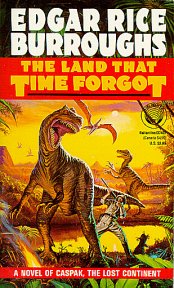
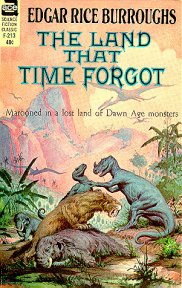
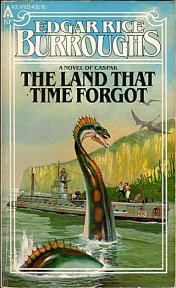




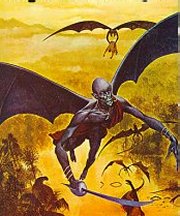
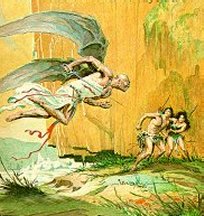
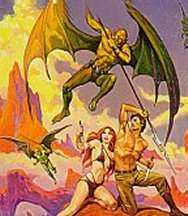
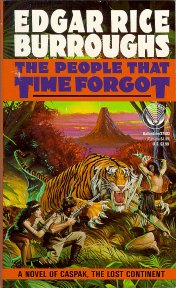
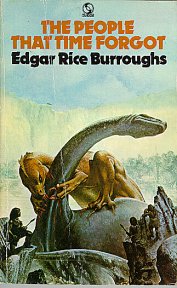
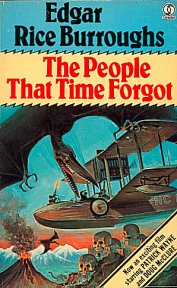
![]()
![]()
![]()
![]()

![]()